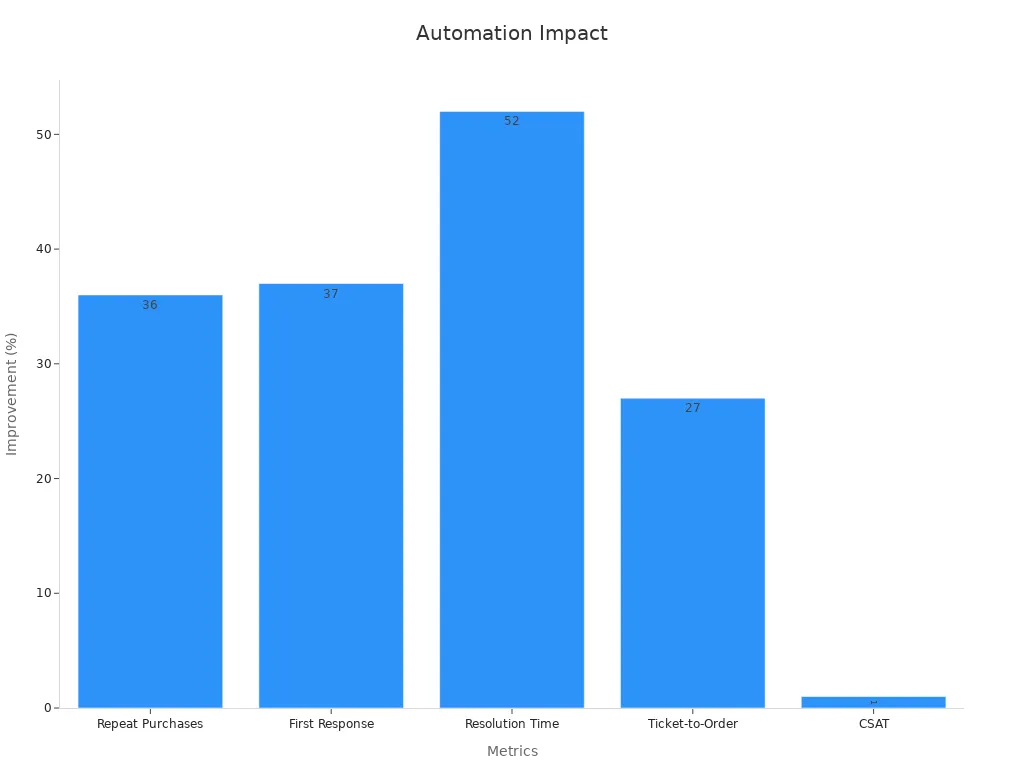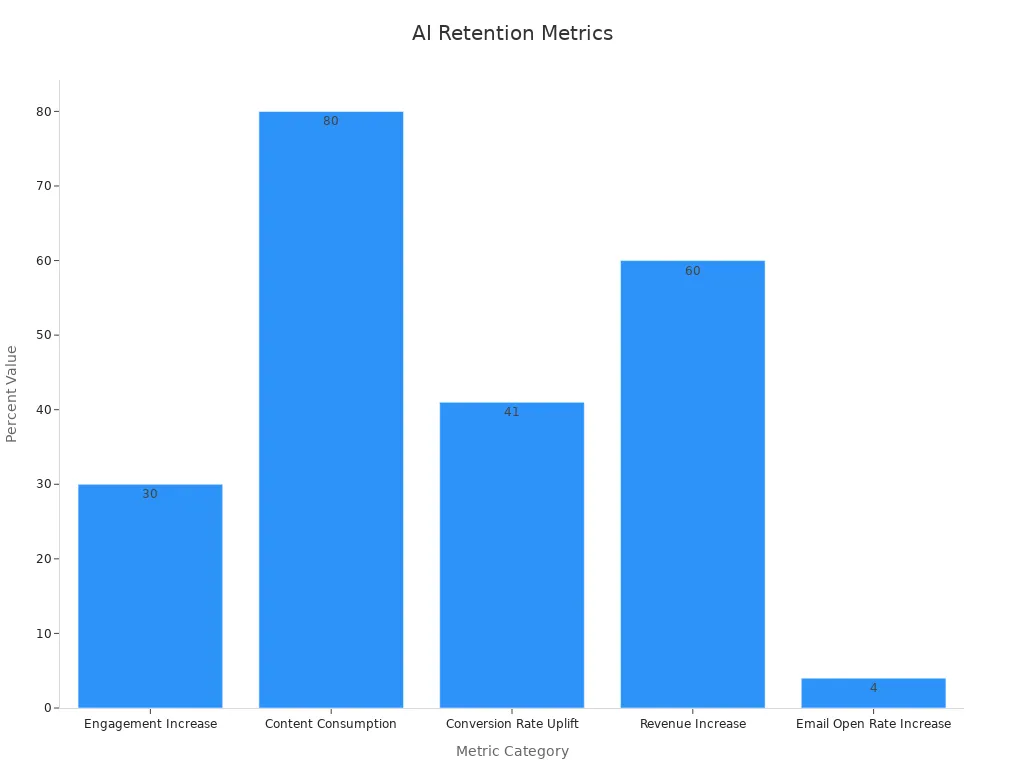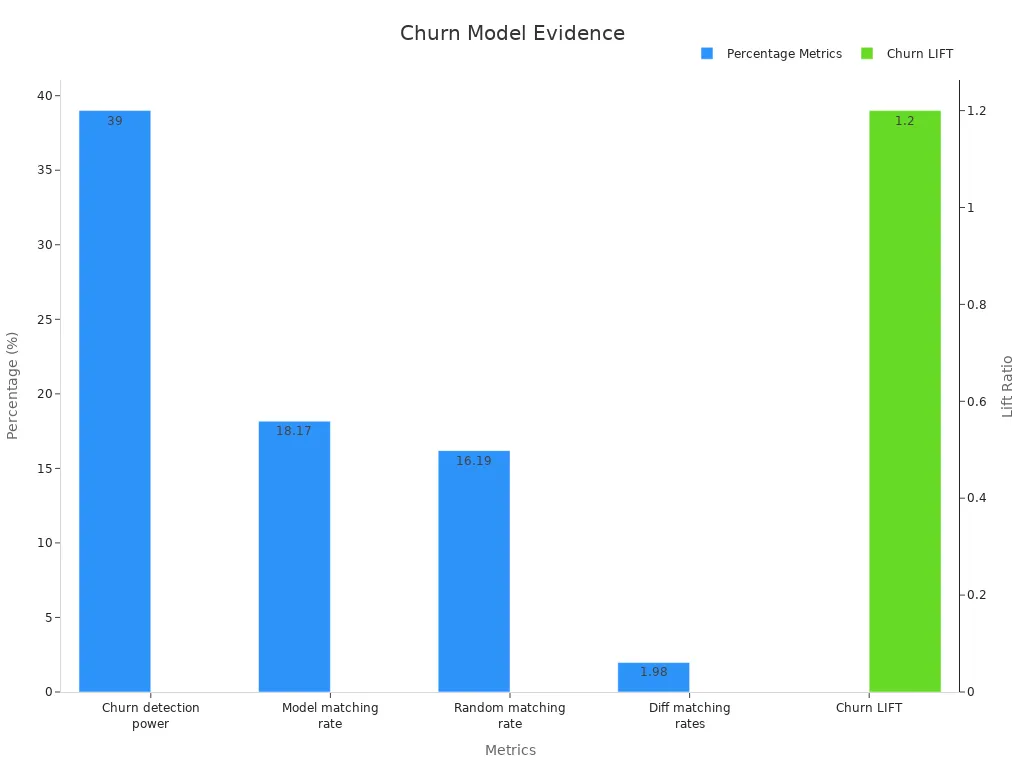Predicting Churn with AI Content Engagement Signals

AI churn prediction focuses on predicting churn by analyzing how customers interact with content to detect subtle changes in behavior. Companies like Netflix and T-Mobile have achieved significant success with predicting churn, as shown below:
Company/Source | AI Application | Key Numerical Statistic | Impact on Churn/Retention |
|---|---|---|---|
Netflix | AI-driven personalization | Churn rate is about 2.3% (Hulu is 4.1%) | Retains about $1 billion in customers annually |
T-Mobile | AI churn prediction models | 20% fewer customers leave | Significant reduction in churn |
Various Organizations | AI for customer success | 25% better retention than manual methods | Improved retention rates |
Various Organizations | AI-driven predictive analytics | Identifies churn risks 60% earlier than traditional methods | Enables proactive customer retention |
By leveraging AI for predicting churn, teams can identify warning signs early and implement strategies to retain customers more effectively. Engaging content and timely alerts help prevent churn and maintain customer loyalty. Segmenting customers allows teams to respond quickly, resulting in higher retention and better overall customer outcomes.
Key Takeaways
AI looks at how people use content to guess if they might leave soon. It finds early hints that someone may stop using the service. Using AI models like random forests and gradient boosting makes churn prediction better. This helps companies act before customers go away. Companies can group customers by risk level. They can also make special plans to keep each group. This helps customers stay longer and helps companies earn more money. Watching users in real time and using automatic actions helps companies react fast. This lowers the number of people who leave. Good data quality and putting data together are very important for AI models to work well. Companies need to clean and update their data often.
Customer Churn
What Is Churn
Churn means how many customers stop buying from a company in a certain time. Companies watch churn to see if they keep their customers. The churn rate is the percent of people who leave out of everyone at the start. For example, if a company has 500 customers and 25 leave, the churn rate is 5%. If the churn rate is high, there might be problems with service or products. If the churn rate is low, most customers stay and are loyal.
Industry | Definition / Formula for Churn Rate | Typical Churn Rate Benchmarks (2024) |
|---|---|---|
SaaS | Churn Rate = (Customers Lost / Total Customers at Start) × 100 | 3-5% annually (healthy), 5-7% annually (enterprise) |
Telecom | Revenue-weighted Churn = (Revenue Lost from Churned Customers / Total Revenue) × 100 | 1.5-2% monthly (acceptable), 1-1.5% monthly (mobile) |
E-commerce | Repeat Purchase Rate = (Number of Repeat Customers / Total Customers) × 100 | 20-35% annually (expected), 20-25% annually (luxury) |
Banking & Financial | Account Dormancy Rate = (Inactive Accounts / Total Accounts) × 100 | 5-7% annually (retail banking), 15-20% annually (credit cards) |
This table shows that each industry checks churn in its own way. Every sector uses a special formula and goal to see how well they keep customers.
Why Churn Matters
Churn affects how well a company does. When customers leave, the company loses money and chances to sell more. High churn can hurt the company’s name if people talk badly about it. Other companies might get these lost customers, making it harder to grow.
If a company keeps 5% more customers, profits can go up by 25% to 95%.
Getting a new customer costs six to seven times more than keeping one.
About 65% of sales come from people who already buy from the company.
Companies have a 60-70% chance to sell to a current customer, but only a 5-20% chance with a new one.
Bad service and lost customers cost businesses over $75 billion every year.
Churn can also mean there are bigger problems, like bad support or wrong marketing. Lowering churn helps companies make more money from each customer, spend less to get new ones, and look steady to investors. Handling churn helps companies become stronger and earn more.
AI Churn Prediction

Engagement Signals
AI churn prediction works by looking at how customers use content. Engagement signals show how often people log in and what features they use. These signals also show how long users stay on the platform. Companies use these signals to see who likes the content and who might leave soon. Predictive AI watches for patterns in how customers use the service. It checks things like session length and which features get used most. This helps spot early signs that someone may stop using the service.
Companies use different ways to measure engagement signals. They split their data into training, validation, and testing sets. This helps make sure the models work for everyone. Machine learning models like logistic regression and random forests help predict churn better. Teams adjust model settings to get the best results. Cross-validation checks if the model works well with different groups of data.
Performance metrics like accuracy, recall, and F1-score show how well the model works.
Confusion matrix analysis helps teams see which predictions are right or wrong.
Feature importance analysis shows which engagement signals matter most.
Models need regular updates with new customer data to stay accurate.
Adding signals like login frequency and session time to other data makes predictions better. Balanced datasets, made with oversampling, help models find churners more easily. Advanced models like random forest and gradient boosting find complex patterns in the data. These steps show that engagement signals are very important for predicting churn and keeping customers.
Tip: Companies that watch engagement signals and focus on good content can stop churn early.
Predictive Models
AI churn prediction uses special models to find customers who might leave. These models look at lots of data and find patterns people might miss. Predictive AI uses algorithms like logistic regression and random forest. Each model has things it does well and things it does not.
Studies show that the Gradient Boosting Machine model can predict churn with 81% accuracy in telecom. Tests proved that GBM worked better than other models. Another study compared logistic regression and random forest for employee churn. Using explainable AI methods like SHAP made the results easier to trust. These studies show that AI models can predict churn well.
When companies pick a model, they look at many things:
Recall is important because missing a real churner costs more.
Confusion matrices help teams see how well the model works.
Models like XGBoost and random forest often get higher recall scores.
Overfitting is checked by comparing training and testing recall.
Tuning model settings helps get the best recall and accuracy.
Ensemble models like XGBoost do better than simple models in many ways.
Scalability and speed matter for big companies.
Interpretability is important for knowing why customers leave, and logistic regression helps with this.
Ensemble models use the best parts of different algorithms to predict churn. These models often get very good results and are a top choice for AI churn prediction. Companies use confusion matrices and ROC curves to check how well models work. With predictive AI, businesses can build strong churn strategies and use data to make decisions.
Predictive AI models help companies sort users by risk level. This lets them target customers who might leave. AI-powered churn prediction helps teams keep more customers and lower churn. Using these models leads to better business results and more customer engagement.
Predicting Churn in Practice
Early Warning Signs
Companies use predictive ai to find signs that a customer might leave. These signs show up before the customer actually stops using the service. Teams look for things like using the product less, logging in less, and not using important features. Other signs are more complaints, missing goals, or getting lower scores like NPS or CSAT. If customers check out other companies or stop talking, they might be at higher risk for churn.
Using the product less and not logging in much
Not talking to the company anymore
Missing important goals or deadlines
Getting lower scores for satisfaction
More complaints or support tickets
By watching these signs, predictive ai helps teams act fast. They can reach out with special help or offers. This way, they can turn customers who might leave into loyal ones. For example, a SaaS company saw a big drop in product use and no logins for two weeks. The customer success manager called the customer, found problems with onboarding, and gave help. The customer started using the product again, so churn was stopped. Early warning signs give companies a chance to stop churn before it happens.
Real-Time Monitoring
Real-time monitoring uses predictive ai to watch what customers do right away. This helps companies see churn risk as soon as it starts. Systems like Kafka and Apache Spark streaming handle lots of data very fast. Predictive ai models like H2O GBM look at this data and send early warnings about churn.
Telecom companies use real-time churn prediction to spot unhappy customers and act fast. Automatic alerts and CRM tools help teams reach out before customers leave. This way, companies can stop churn before it gets worse. Companies keep more money, make customers happier, and make better choices. Real-time monitoring helps teams use churn prediction right away. Companies that use these tools have fewer customers leave and get more value from each customer.
Actionable Steps
Segmenting At-Risk Users
AI churn prediction helps companies sort users by risk level. Users can be high, medium, or low risk. Teams focus on people most likely to leave. AI-powered churn prediction uses data from user actions and buying history. It also uses engagement signals to put customers into groups. Segmentation splits customers by what they do or have in common. This makes it easier to send the right message to each group.
Segmentation puts customers in groups by how they act, like how often they buy or spend.
Cohort analysis watches groups over time to find patterns and help keep customers.
Using segmentation with scores like Net Promoter Score (NPS) and retention rates gives more details about which groups might leave.
Customer Lifetime Value (CLV) helps teams focus on important users to keep them.
Adoption rate shows which customers use the product less and may need extra help.
AI churn prediction lets companies stop churn before it happens. Teams use these ideas to start special campaigns and fix problems. Numbers like how often someone buys or how recent their last buy was help spot users who are not active. Predictive analytics uses this data to guess who might leave and helps teams keep more customers.
Companies that use segmentation and AI-powered churn prediction see a 15–20% better retention rate in the first year. Hydrant, for example, got a 260% higher conversion rate and a 310% increase in money per customer by targeting likely churners with special campaigns.
Personalizing Retention
Personalization is very important for keeping customers. AI looks at customer data to make special experiences, offers, and messages. This makes each customer feel special and understood. Personalized messages make it more likely that at-risk users will stay.
AI uses churn prediction to pick the best time and way to reach out.
Personalized offers, like discounts or special content, meet each user’s needs.
AI checks satisfaction scores and feedback to change retention plans quickly.
Teams use data to send reminders, tips, or rewards based on what users do.
A small increase in retention, like 5%, can raise profits by 25% to 95%. Keeping current customers costs less than getting new ones. Long-term customers buy more, stay loyal, and help the company grow. Personalized retention builds trust and makes customers less likely to leave for another company. These plans also help companies earn steady money and plan ahead.
Personalization with AI leads to more steady money and better use of resources. Companies can focus on keeping current customers, which helps the business stay strong and grow.
Automated Interventions
Automation makes keeping customers faster and easier. AI-powered churn prediction starts automatic actions when a user might leave. These actions include sending emails, giving discounts, or telling support teams. Automation makes sure no at-risk customer is missed.
Metric | Improvement with Automation |
|---|---|
Increase in repeat purchases | 36% |
Reduction in first response time | 37% |
Reduction in resolution time | 52% |
Decrease in ticket-to-order ratio | 27% |
Increase in customer satisfaction (CSAT) | 1% |

AI-driven automation makes customer service better and solves problems faster. Quick replies and fixes make customers feel important. These changes help keep more customers and lower churn. Automated actions also let teams work on harder problems that need people.
AI-powered churn prediction and automation help companies act fast and the same way every time. This helps stop churn and makes sure every at-risk user gets help.
Key Benefits of AI-Driven Actionable Steps:
AI tags users by churn risk, so teams can target them.
Segmentation and personalization make retention campaigns better.
Automation saves time and lowers churn.
Data-driven retention plans help companies earn more and stay strong.
Case Studies

Media Platform Example
Media platforms get big results from using AI engagement analysis. A top streaming service made its churn prediction much better, going from 52% to 91%. The number of wrong alerts dropped to between 3% and 6%. This helped the company act fast and keep more viewers. The churn rate went down by as much as 15%. More people watched, with engagement going up over 20%. AI ideas made retention plans twice as good and helped subscribers stay longer.
Metric | Result / Improvement |
|---|---|
Churn Prediction Accuracy | Improved from 52% to 91% |
False Positive Rate | 3% to 6% |
Churn Rate Reduction | Up to 15% decrease |
Viewer Engagement | Over 20% increase |
Retention Strategy Effectiveness | Doubled effectiveness |
Revenue Impact | Increased via longer subscriptions |
AI also made recommendations more personal. About 80% of what people watched came from these picks. Social media activity went up by 30%. Fast replies made customers happier. The company worked better and made more content.

AI-powered engagement analysis helps media platforms keep viewers, make them happier, and earn more money.
SaaS Example
SaaS companies use AI churn prediction to keep customers and save money. One SaaS company made its churn model better by adding more data. Leaders could act before customers left. Another company used dotData’s analytics to find over 50 churn predictors. This saved $40 million each year.
Example / Model | Quantitative Outcome / Metric | Impact / Significance |
|---|---|---|
Escalent SaaS Case Study | Improved churn prediction accuracy with more data variables | Enabled proactive retention actions |
dotData Managed Predictive Analytics | Identified 50+ churn predictors; saved $40 million annually | Large financial savings from AI churn prediction |
Decision Trees | Up to 100% accuracy in some cases | Highly accurate churn classification |
Random Forests | Improved robustness and accuracy | Handles large data, reduces overfitting |
AI models like decision trees and random forests help SaaS teams find users who might leave. These models work with lots of data and make fewer mistakes. Because of this, SaaS companies keep more customers, spend less, and work better. AI churn prediction gives SaaS companies a strong advantage in a tough market.
Challenges in Churn Prediction
Data Quality
Good data is very important for churn prediction. If data is wrong or missing, models do not work well. When there are too many features, it is hard to pick the best ones. It also makes models harder to understand. Customers change how they act, and companies may not agree on what churn means. These problems make it hard to build good models.
Teams use special ways to fill in missing data, like using the average or middle value.
Outliers can mess up results, so teams fix them by cutting off extreme values.
Models need good data to get high accuracy, recall, and F1-score.
Checking and cleaning data often helps models stay strong.
Companies should get data ready and keep making their process better. If they do not, even the best ai tools will not predict churn well.
Model Accuracy
It is hard to make churn models very accurate. Even smart ai models sometimes only do a little better than guessing. The table below shows how tough it is to get strong results:
Metric | Value | Interpretation |
|---|---|---|
~39% | Models only find about 39% of churners in tests | |
Churn LIFT | ~1.2 | Models are just a bit better than the average churn rate |
Average matching rate (model) | 18.17% | Only about 18% of high-risk users picked by the model actually churned |
Average matching rate (random) | 16.19% | About 16% of random users churned |
Difference in matching rates | 1.98% | The model is just a little better than random (p=0.0002) |

These numbers show that ai models may only be a little better than guessing. Teams need to keep testing and improving to get better results.
Integration
Bringing data together for ai churn prediction is hard. Many companies have data in different places and in different formats. There is also a lot of data to handle. These things make it tough to look at data the right way.
If data is missing, old, or repeated, people may not trust ai results.
A report showed that 77% of data workers want to use data, but only 46% trust it.
Bad integration can make models unfair and give wrong answers.
To fix this, companies need to collect, clean, and check data carefully. Checking data often helps keep it good. Without good integration, even the best ai models cannot predict churn well.
AI churn prediction helps companies keep more customers in many fields. Some companies saw churn go down by 14% after using AI and special plans to keep users. Groups like fintech and healthcare have fewer people leaving and happier customers when they use AI ideas. Teams should look at how they keep customers now and try out AI tools or talk to experts. Doing this can help companies keep more customers and do better than others.
Aspect | Details |
|---|---|
Company | Beauty box subscription company |
Outcome (Numerical) | 14% reduction in churn among treated cohort |
FAQ
What are AI content engagement signals?
AI content engagement signals are things like logins, clicks, and time spent. They also include which features people use. These signals show how users interact with content. Teams look at this data to find early signs of churn. This helps them make better plans to keep customers.
How does AI predict customer churn?
AI uses machine learning models to study how users act. These models find patterns that mean a customer might leave. Teams use these predictions to keep more customers. This helps lower churn.
Why is real-time churn prediction important?
Real-time churn prediction helps teams act fast for at-risk users. Quick action can stop customers from leaving. Companies get higher retention and happier customers with real-time alerts.
Can AI churn prediction work for small businesses?
Yes, small businesses can use AI churn prediction too. Many tools are easy to set up and not expensive. Small teams can use these insights to help high-risk users. This helps build customer loyalty.
What data does a company need for AI churn prediction?
A company needs data on user activity, buying history, and engagement. Clean and correct data helps AI models work better. Teams should collect and update this data often for the best results.
See Also
Strategies To Analyze Content And Beat Your Competition
Top SEO Trends And Forecasts To Follow In 2024
Using TikTok Analytics To Boost Audience Interaction Effectively
Comparing Writesonic AI And QuickCreator For Content Creation
Complete Guide To Achieving SEO Excellence Using Perplexity AI

